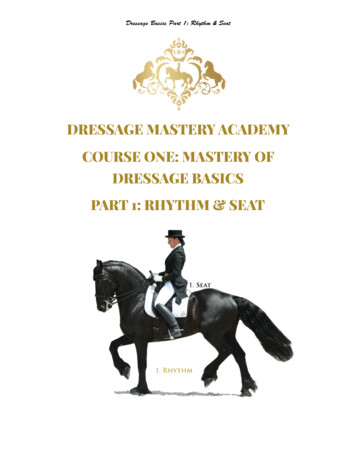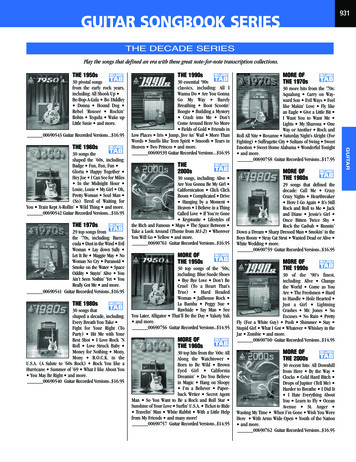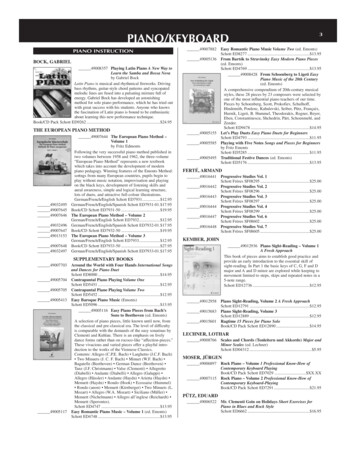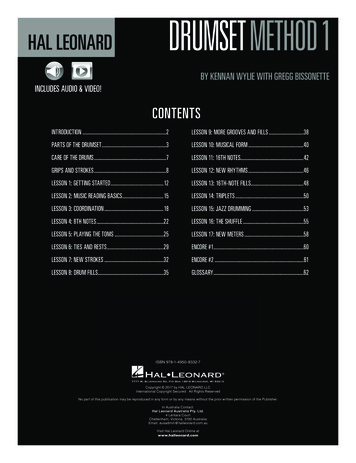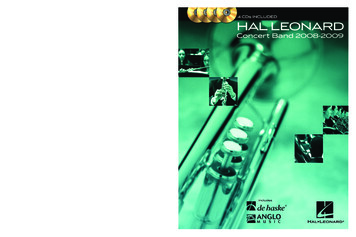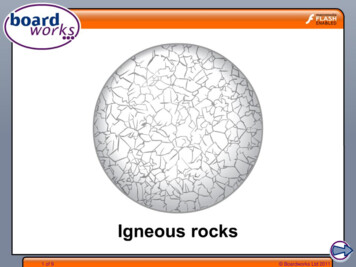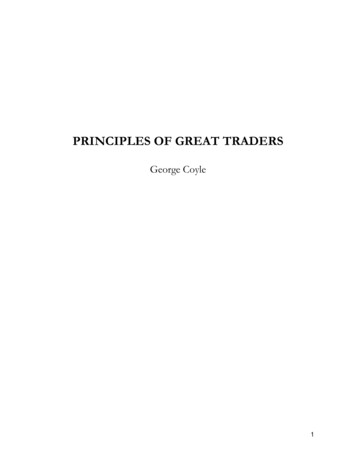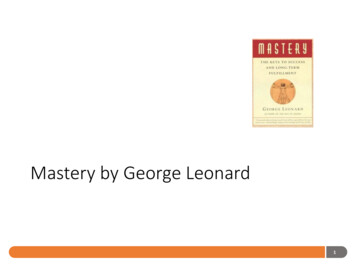
Transcription
Mastery by George Leonard1
At the heart of it, masteryis practice. Mastery isstaying on the path.George Leonard (1923 - 2010)A pioneer in the field of human potentialities, is author oftwelve books, including The Transformation, Education andEcstasy, The Silent Pulse, the Ultimate Athlete and MasteryThe last thirty years of his life have been inspired by Aikido2
1Introduction2What is Mastery?3The Master’s Journey4The Five Master Keys5Tools For Mastery6Conclusion7Appendix3
IntroductionWhat makes an Olympic athlete or a NobelPrize-winner different from the rest of us?What separates someone who is successfulin health and fitness?Are successful people cut from a differentcloth?Success doesn’t just happen. Successful people follow a process,they put in massive amounts of work and fail over and over beforethey ‘make it’. Success isn’t chance, Success is mastery.4
Part 1 - The Master’s Journey5
Chapter 1Mastery is A journey The process where what was difficultbecomes easier A life long commitment to hone yourskills Being goalless Realizing that the ultimate goal is thepath to mastery itself Practicing, even when you seem to begetting nowhere6
The Common MisconceptionMost time spent at a skill level is spent on a plateau where you donot improve and are often frustrated. Afterwards you will improve alot then get a little worse and return to another plateau; which is animprovement to your previous plateau.Realistic model7
Chapter 2Dabbler The dabbler tries many things, getsimprovement, plateaus and gets bored then triessomething new.Obsessive The obsessive is purely result oriented. They areinconsistent and when they hit a plateau theyquit because their results aren’t increasinglinearlyHacker The hacker is content where he’s at. He getsgood then doesn’t care to continue improving.8
There is nothing wrong with being the dabbler, theobsessive, or the hacker. Everyone is sometimes all ofthem. But if you want to become a master at a certainskill, you must stay on the path of mastery.Which are YOU?DabblerObsessiveHackerJack of alltrades andmaster of noneFull throttleuntil enginecrashNo reason tomove fromEasy Street9
Chapter 3 America’s War Against MasteryMarketing and culture tend to communicate quick fixes and instantgratification. It communicates learning being linear or instantaneous.Which is not reality.10
Anti-Mastery BehaviorEye only on thePrize!Results areeverythingDrugs forcompetitive edgeCelebrity StatusThe Quick-FixMentalityInstantGratificationFast MoneyBuy it NowGamble asopposed to earnSpend more thanyou haveMoney iseverythingNo need to buildwealth11
The Path of Endless Climax A war that cannot be wonHEADLINE:Drugs and Today’s Wall Street Leads to a Bitter Crash12
Chapter 4 Loving the Plateau Find joy in regular practice Practice for the sake of practice itself, NOTfor reaching a certain level Appreciate what is most essential andenduring in your lifeWe are taught in countless ways to enjoy the prize, the climaticmoment, but a true life of mastery is spent in the plateau.13
Relish the JourneyWhere in our upbringing, our schooling, ourcareer are we explicitly taught to value, to enjoyand to love the plateau, the long stretch ofdiligent effort with no seeming progress?1414
Trying to Escape the Plateau could create a restless life full of distractionsor self-destruction.15
Part 2 – Five Mastery KeysMASTERY16
Chapter 5 Key 1: Instruction A good instructor willpoint out both thegood and the bad Understand teachersare not perfect Know when it is time tosay good bye to ateacher The good thing aboutno instruction is youhave unlimitedpotential as nobodywill tell you somethingwill not work The bad thing is it cantake much longer tolearn and you will nothave anyone to helpyou along the way17
Chapter 6 Key 2: PracticePractice is NOT something you do, it’s something you ARELarry BirdJerry RiceBill GatesStartedpracticingbasketball atage 4 andneverstoppedHardestworking andmostdisciplinedreceiver inNFL historyAt 13 yearsof age had10,000 hourspractice incomputerprogramming18
Chapter 7 Key 3: Surrender Surrender to your teacher and the demands ofyour discipline Be willing to look like a fool There are times when we forfeit hard-woncompetency in order to advance to the nextstage. (Like when a golfer decides to change his orher swing)For the master, surrender means there are noexperts, only learners.19
Chapter 8 Key 4: IntentionalityVisualizationsThoughts,images andfeelings play intoyour successIntentionalityfuels themaster’s journeyEvery master is amaster of visionJack Nicklaus Always pictured golf shot before swing Believed only 10% of success of shot due toswingArnold Schwarzenegger Believed that pumping a weight one timewith full consciousness was worth 10 withoutmental awarenessSir James Jeans (astronomer) More and more, the universe looks like agreat thought rather than a great machine20
Chapter 9 Key 5: The Edge Pushing the limits forhigher performance,sometimes to thepoint of stupidity You must be able toplay the edge whilerespecting practiceChuck YeagerAgony of DefeatFirst pilot to breakthe sound barrierin X-1 rocket plane.Julie Moss, 23,collapsed andcrawled to finishHawaii’s IronmanTriathlon WorldChampionship.Injured at the time,used a broomhandle to closerocket door.Heroic or stupid?21
Part 3 – Tools for MasteryMASTERY22
Chapter 10Why Resolutions Fail & What to Do About It Everyone resists change, good orbad. Expect some backsliding. Resistance to change isproportional to size/speed ofchange, not if it is good or bad. Be aware of how homeostasisworks. Develop a support system.Particularly those who have gonebefore you.23
Chapter 11 Getting Energy for Mastery You gain energy by using energy Maintain physical fitness Acknowledge the negative andaccentuate the positive Be honest with others, it willrevitalize you Set your priorities Make your commitments, takeaction Get on the pathway of mastery, andchoose to stay on it24
Chapter 12 Pitfalls Along the Path1.2.3.4.5.6.7.8.9.10.11.12.13.Conflicting Way of LifeObsessive Goal OrientationPoor InstructionLack of CompetitivenessOver CompetitivenessLazinessInjuriesDrugsPrizes and MedalsVanityDead SeriousnessInconsistencyPerfectionism Your job may not be yourpath. Your teacher is a teacher,not a guru. Competition keeps youmotivated. External validation canoften stop or slow thepathway to mastery You must be willing tolook like a fool. Have fun.25
Chapter 13 Mastering the CommonplaceNothing in life is “commonplace”. Nothing is “inbetween”. The threads that join our every act,our every thought, are infinite. All paths ofmastery eventually merge.26
Chapter 14 Packing for the JourneyChecklist Five Keys to Stay on the Path Tips to Energize and Avoid PitfallsReturning to Center Meditation & Yoga Discover your “Personal Ki”Unexpected Blows Take the hit as a gift Unleash your Power and Unused Potential27
Epilogue The Master and the Fool Always be a student Never believe that your cup is full Preconceived notions of what is foolish may inhibit your path to mastery Always wear your White BeltWhat we frown at as foolish in our friends,ourselves, we’re likely to smile at as merelyeccentric in a world-renowned genius.28
Mastery is 1. The process where what was difficult becomes both easier and more pleasurable;2. Long-term dedication to the journey – not the bottom line;3. Gaining mental discipline to travel further on your journey;4. Being goal-less;5. Realizing that the pleasure of practice is intensified;6. Creating deep roots;7. Knowing that you will never reach a final destination;8. Being diligent with the process of mastery;9. Your commitment to hone your skills;10. After you have reached the top of the mountain, climb another one;11. Being willing to practice, even when you seem to be getting nowhere;12. Making this a life process;13. Being patient, while you apply long-term efforts;14. Appreciating and even enjoying the plateau, as much as you do the progress;15. Practicing for the sake of practice;16. Winning graciously, and losing with equal grace;17. Placing practice, discipline, conditioning and character development before winning;18. Being courageous;19. Being fully in the present moment;20. Realizing that the ultimate goal is not the medal, or the ribbon, but the path to mastery itsself (The “I am” stage);21. Being willing to look foolish;22. Maintaining flexibility in your strategy, and in your actions;23. A journey; and,24. Determination29
About the AuthorGeorge Burr Leonard (1923 – January 6, 2010) was an American writer, editor,and educator who wrote extensively about education and human potential. Hewas President Emeritus of the Esalen Institute, past-president of the Associationfor Humanistic Psychology, President of ITP International, and a former editor ofLook Magazine. He was also a former United States Army Air Corps pilot, and helda fifth degree black belt in aikido. Leonard was a co-founder of the Aikido ofTamalpais dojo in Corte Madera, California. He also developed the LeonardEnergy Training (LET) practice for centering the mind, body, and spirit. Leonarddied at his home in Mill Valley, California on January 6, 2010 after a long illness.He was 86 years old.Books The Decline of the American Male (1958) ASIN B000JWGFBWShoulder the Sky (1959) ASIN B000HLSI5QThe Man & Woman Thing, and Other Provocations (1970) ASIN B0006DY0R0The Transformation (1981) ISBN 9780874771695The End of Sex (1983) ISBN 9780091528300Education and Ecstasy (1987) ISBN 9781556430053Walking on the Edge of the World (1988) ISBN 9780395483114Mastery: The Keys to Success and Long-Term Fulfillment (1992) ISBN 978-0452267565The Life We Are Given (1995) ISBN 9780874778533The Way of Aikido: Life Lessons from an American Sensei (2000) ISBN 978-0452279728The Ultimate Athlete (2001) ISBN 9781556433498The Silent Pulse (2006) ISBN 978142360122730
George Leonard (1923 - 2010) A pioneer in the field of human potentialities, is author of twelve books, including The Transformation, Education and Ecstasy, The Silent Pulse, the Ultimate Athlete and Mastery

